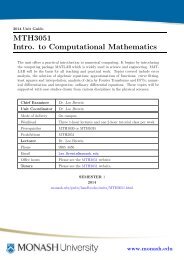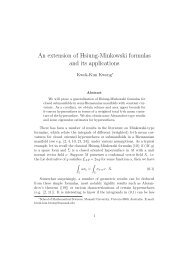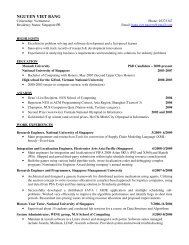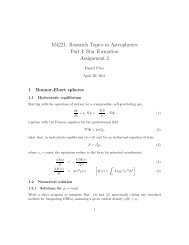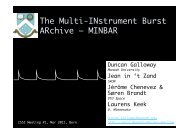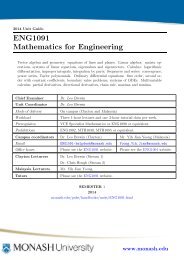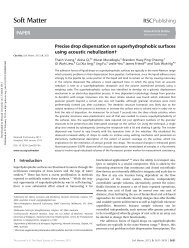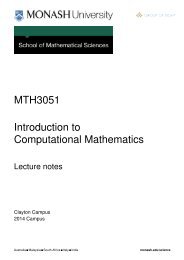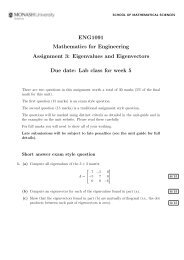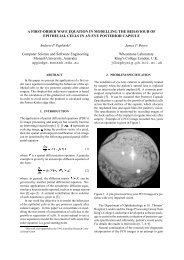Intersection theory on moduli spaces of curves ... - User Web Pages
Intersection theory on moduli spaces of curves ... - User Web Pages
Intersection theory on moduli spaces of curves ... - User Web Pages
Create successful ePaper yourself
Turn your PDF publications into a flip-book with our unique Google optimized e-Paper software.
30 1. A gentle introducti<strong>on</strong> to <strong>moduli</strong> <strong>spaces</strong> <strong>of</strong> <strong>curves</strong>There is clearly a projecti<strong>on</strong> map T g,n (L) → M g,n (L) given by forgetting the marking. In fact,we obtain the <strong>moduli</strong> space as a quotient <strong>of</strong> Teichmüller space by a group acti<strong>on</strong>. C<strong>on</strong>sider themapping class groupMod g,n = Diff + (S g,n )/Diff + 0 (S g,n),where Diff + (S g,n ) is the group <strong>of</strong> orientati<strong>on</strong> preserving diffeomorphisms fixing the boundariesand Diff + 0 (S g,n) is the normal subgroup c<strong>on</strong>sisting <strong>of</strong> those diffeomorphisms isotopic to theidentity. There is a natural acti<strong>on</strong> <strong>of</strong> the mapping class group <strong>on</strong> Teichmüller space describedas follows: if [φ] is an element <strong>of</strong> Mod g,n , then [φ] sends the marked hyperbolic surface (X, f )to the marked hyperbolic surface (X, f ◦ φ).Propositi<strong>on</strong> 1.25. The acti<strong>on</strong> <strong>of</strong> Mod g,n <strong>on</strong> T g,n (L) is properly disc<strong>on</strong>tinuous, though not necessarilyfree. Therefore, the quotient M g,n (L) = T g,n (L) / Mod g,n is an orbifold.Compactificati<strong>on</strong> and symplectificati<strong>on</strong>Earlier, we described the Deligne–Mumford compactificati<strong>on</strong> M g,n , obtained by c<strong>on</strong>sideringstable algebraic <strong>curves</strong>. It should be noted that there is an analogous c<strong>on</strong>structi<strong>on</strong> in the hyperbolicsetting, where a node <strong>of</strong> an algebraic curve corresp<strong>on</strong>ds to degenerating the length <strong>of</strong>a simple closed curve <strong>on</strong> a hyperbolic surface to zero. In fact, <strong>on</strong>e can c<strong>on</strong>struct T g,n (L), theTeichmüller space <strong>of</strong> marked stable hyperbolic surfaces, in the following way. Define a stablehyperbolic surface <strong>of</strong> type (g, n) to be a pair (X, M) where X is a surface <strong>of</strong> genus g with npunctures, M is a collecti<strong>on</strong> <strong>of</strong> disjoint simple closed <strong>curves</strong> <strong>on</strong> X and X \ M is endowed witha finite area hyperbolic metric. Again, we refer to a diffeomorphism f : S g,n → X as a markingand define the compactified Teichmüller space{T g,n (L) = (X, M, f )∣}/f is a marking <strong>of</strong> a stable hyperbolic surface (X, M) <strong>of</strong>∼genus g with n boundaries <strong>of</strong> lengths L 1 , L 2 , . . . , L nwhere (X, M, f ) ∼ (Y, N, g) if and <strong>on</strong>ly if there exists a homeomorphism φ : X → Y such thatφ(M) = N, φ restricted to X \ M is an isometry, and φ ◦ f is isotopic to g <strong>on</strong> each c<strong>on</strong>nectedcomp<strong>on</strong>ent <strong>of</strong> S g,n \ f −1 (M). Once again, the mapping class group acts <strong>on</strong> the compactifiedTeichmüller space and <strong>on</strong>e may define a compactificati<strong>on</strong> <strong>of</strong> the <strong>moduli</strong> space M g,n (L) asM g,n (L) = T g,n (L)/Mod g,n .The <strong>moduli</strong> space M g,n (0) can be can<strong>on</strong>ically identified with M g,n by the uniformisati<strong>on</strong> theorem.When L ̸= 0, the <strong>moduli</strong> space M g,n (L) does not possess a natural complex structure.However, by the work <strong>of</strong> Wolpert [61], the Fenchel–Nielsen coordinates do induce a real analyticstructure. For more informati<strong>on</strong> <strong>on</strong> the compactificati<strong>on</strong> and real analytic structure <strong>of</strong><strong>moduli</strong> <strong>spaces</strong> <strong>of</strong> hyperbolic surfaces, the reader is encouraged to c<strong>on</strong>sult the references [1, 3].



